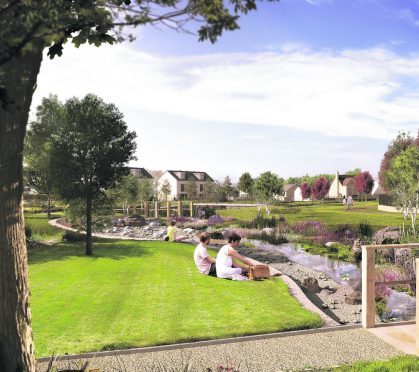It’s not just people who will be flourishing in the new community of Countesswells, wildlife will bloom too, thanks to the focus on biodiversity across the 160-hectare site.
Biodiversity, or biological diversity to give it its full name, refers to the number and variety of plants, animals and other organisms which co-exist in a particular habitat. The more biodiversity there is in an area, the healthier an environment becomes.
This is a key element of the vision for Countesswells, a community integrated with the surrounding landscape and well connected with the natural world so that its residents enjoy an enhanced quality of life in terms of the environment within and around their homes.
A quarter of the total community area is dedicated to open space, including four main parks, which enhance the existing landscape features. The parkland being developed in the first phase includes almost 600 metres of burn channel, more than 1.7 kilometres of new paths, four new bridges over the burn, an orchard, two play parks and areas of amenity lawn and wildflower meadow.
Environmental consultancy Ironside Farrar Ltd carried out environmental and ecological surveys at Countesswells during the planning process and helped shape the design of the community’s green framework to improve the levels of wildlife and plant species on site.
Kim McLaren, technical director at Ironside Farrar, said: “When the masterplan for Countesswells was developed, the public green spaces were a key consideration. With the new community being built on former agricultural land which had limited biodiversity, improving the diversity of plant and animal species on site was something which we were very keen to achieve.”
Important to enhancing biodiversity on the site was the process of creating an attractive place for fauna and flora to live and grow, as well as residents.
Kim said: “One of the aspects of the site which limited biodiversity was the lack of water features and bodies of water. As part of the plans now being implemented, the burn which runs through the community is being opened up to create the Cults Burn Park, which will cover 11 hectares and will be the largest of four parks in Countesswells. This will create an ecological park and will provide an important habitat for insects, bats and birds and a safe route for wildlife moving through the area.
“There are currently around 32 species of bird which visit the land, including house sparrow, northern lapwing, robin, sky lark, song thrush and yellowhammer. Native broadleaved species and grassland is being planted around the Cults Burn to encourage insects and provide food and shelter for the birds.”
Green paths across the neighbourhoods will provide safe walking, cycling and riding routes through the community and will connect homes with amenities, including the schools. They will also connect the existing Hazlehead and Countesswells woods which are situated either side of the community.
Kim explained: “The green links will provide habitat for a whole range of species including the small heath butterfly and red squirrels. We are particularly keen to encourage native red squirrels onto the site and we are working with Aberdeen City Council with advice from the Saving Scotland’s Red Squirrels campaign.”
Extensive new tree planting will begin at Countesswells this winter when more than 600 trees, including Scots pine, birch, oak, lime, horse chestnut, alder, hornbeam, rowan, cherry and willow will be planted.
More than one hectare of wildflower turf and seeding will also be planted with 34 UK native wildflowers and grasses.
Kim said: “As well as introducing new elements to Countesswells, there are a number of mature trees on the land which have been included in the masterplan. The existing species of tree include beech, birch, ash, sycamore, alder, lime and wych elm. One of the benefits of these trees is that they provide a roosting habitat for birds and bats which will be enhanced through the introduction of more native tree species through the planting programme.”
The new community at Countesswells will have 3,000 homes – ranging from apartments to detached homes – set around a distinctive series of public squares and parks, well connected with pathways and cycle routes that will link new schools, leisure and health facilities, as well as retail and business space.
